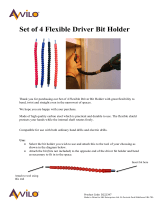Festool C12 EC-TEC User manual
- Category
- Cordless combi drills
- Type
- User manual
Festool C12 EC-TEC is the latest and greatest in cordless drill technology. With its revolutionary EC-TEC brushless motor, it delivers more power, speed, and runtime than any other drill in its class. The EC-TEC motor is also incredibly efficient, so you can get more work done on a single charge.
But that's not all. The C12 EC-TEC also features an intelligent electronic controller that protects the motor from damage. This means you can push the drill as hard as you want without worrying about burning it out.
Other features of the C12 EC-TEC include:
- A 24-position torque clutch for precise control when driving screws
Festool C12 EC-TEC is the latest and greatest in cordless drill technology. With its revolutionary EC-TEC brushless motor, it delivers more power, speed, and runtime than any other drill in its class. The EC-TEC motor is also incredibly efficient, so you can get more work done on a single charge.
But that's not all. The C12 EC-TEC also features an intelligent electronic controller that protects the motor from damage. This means you can push the drill as hard as you want without worrying about burning it out.
Other features of the C12 EC-TEC include:
- A 24-position torque clutch for precise control when driving screws





-
 1
1
-
 2
2
-
 3
3
-
 4
4
-
 5
5
Festool C12 EC-TEC User manual
- Category
- Cordless combi drills
- Type
- User manual
Festool C12 EC-TEC is the latest and greatest in cordless drill technology. With its revolutionary EC-TEC brushless motor, it delivers more power, speed, and runtime than any other drill in its class. The EC-TEC motor is also incredibly efficient, so you can get more work done on a single charge.
But that's not all. The C12 EC-TEC also features an intelligent electronic controller that protects the motor from damage. This means you can push the drill as hard as you want without worrying about burning it out.
Other features of the C12 EC-TEC include:
- A 24-position torque clutch for precise control when driving screws
Ask a question and I''ll find the answer in the document
Finding information in a document is now easier with AI
Related papers
-
Festool CDD 9.6 FX User manual
-
Festool 8717825460002 Datasheet
-
Festool CXS User manual
-
Festool C12 LI Owner's manual
-
Festool Compact Saw and Cordless Drill User manual
-
Festool PD561608 User manual
-
Festool 564514 User manual
-
Festool TXS Operating instructions
-
Festool 564274 User manual
-
Festool TDK 12 User manual
Other documents
-
Manson VWM-4108 User manual
-
 Avilo D222347 Operating instructions
Avilo D222347 Operating instructions
-
Milwaukee 4933431340 Datasheet
-
Milwaukee 4933443334 Datasheet
-
Campbell Hausfeld Cordless Drill DG100600CK User manual
-
Hitachi DS18DVB2 User manual
-
JET JTM-1050EVS/230 Owner's manual
-
Metabo 602298610 Datasheet
-
Hitachi 93121601 Datasheet
-
Hitachi DH 24DV Technical Data And Service Manual





